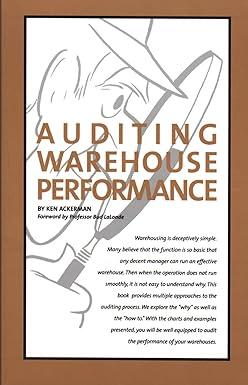Question
The ABC Company performs its expenditure cycle activities using its integrated ERP system as follows: Employees in any department can enter purchase requests for items
The ABC Company performs its expenditure cycle activities using its integrated ERP system as follows:
Employees in any department can enter purchase requests for items they note as either out of stock or in small quantity. The company maintains a perpetual inventory system. Each day, employees in the purchasing department process all purchase requests from the prior day. To the extent possible, requests for items available from the same supplier are combined into one larger purchase order to obtain volume discounts. Purchasing agents use the internet to compare prices in order to select suppliers. If an internet search discovers a potential new supplier, the purchasing agent enters the relevant information in the system, thereby adding the supplier to the approved supplier list. Purchase orders above $10,000 must be approved by the purchasing department manager. EDI is used to transmit purchase orders to most suppliers, but paper purchase orders are printed and mailed to suppliers who are not EDI capable. Receiving department employees have read-only access to outstanding purchase orders. Usually, they check the system to verify existence of a purchase order prior to accepting delivery, but sometimes during rush periods they unload trucks and place the items in a corner of the warehouse where they sit until there is time to use the system to retrieve the relevant purchase order. Whenever a discrepancy is greater than 5%, the receiving employee sends an email to the purchasing department manager. The receiving employee uses an online terminal to enter the quantity received before moving the material to the inventory stores department. Inventory is stored in a locked room. During normal business hours, an inventory employee allows any employee wearing an identification badge to enter the storeroom and remove needed items. The inventory storeroom employee counts the quantity removed and enters that information in an online terminal located in the storeroom. Occasionally, special items are ordered that are not regularly kept as part of inventory from a specialty supplier who will not be used for any regular purchases. In these cases, an accounts payable clerk creates a one-time supplier record. All supplier invoices (both regular and one-time) are routed to accounts payable for review and approval. The system is configured to perform an automatic three-way match of the supplier invoice with the corresponding purchase order and receiving report. Each Friday, approved supplier invoices due withing the next week are routed to the treasurers department for payment. The cashier and treasurer are the only employees authorized to disburse funds, either by EFT or by printing a check. Checks are printed on a dedicated printer located in the treasurers department, using special stock paper stored in a locked cabinet accessible only to the treasurer and cashier. The paper checks are sent to accounts payable to be mailed to suppliers. Monthly, the treasurer reconciles the bank statements and investigates any discrepancies with recorded cash balances
Instructions:(1) A description of the process, (2) A document flowchart, and (3) suggestions for new internal controls that should be implemented.
Step by Step Solution
There are 3 Steps involved in it
Step: 1

Get Instant Access to Expert-Tailored Solutions
See step-by-step solutions with expert insights and AI powered tools for academic success
Step: 2

Step: 3

Ace Your Homework with AI
Get the answers you need in no time with our AI-driven, step-by-step assistance
Get Started


